
A short trip led us again over the Arno to Santo Spirito, a
yellow-washed building and Brunelleschi's last church. In the
monastery attached to this church, Michelangelo carried out
dissections. For carrying out dissections - body-stripping -
there was a death-sentence. But the prior gave him the key to
the mortuary because he took his profits from it: he was doctor
himself and it was Michelangelo and Leonardo, who were the first
to make visible the insides of a human. Well, he was never caught.
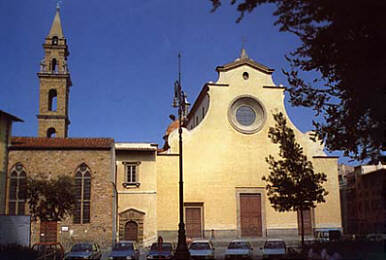
It isn't far to Santa Maria del Carmine and the Brancacci-chapel.
Church and monastery had been established in 1268 for the Carmelite
order, In 1771 the church room was destroyed by a fire and left
nothing but the sacristy and the Cappella Brancacci. They considered
whether to pull it down, only the German painter Adolph Mengs -
in Florence to study work - spoke up for it not to destroy it. What
pillocks.
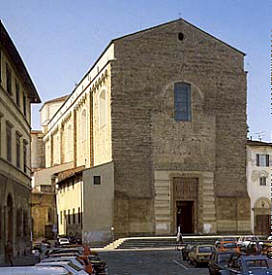
Donator of the freschi-cycle was the silk-merchant Felice
Brancacci who gave commission to Masolino da Panicale who
started in 1424. Three years later he included his young colleague
Masaccio (you remember the real renewer of Giotto's style).
Together they painted huge freschi of the new Testament which were a
break-through for Florence art and for the whole world.
But Masolino was called to Rome in 1427, Masaccio followed him and
died there one year later in a mysterious way. What happend to
Masolino? He died in 1440, why he never returned to Florence to
finish the chapel's paintings? Another mystery. The chapel was
unfinished until Filippino Lippi finished the cycle in 1485 while
he imitated Masaccio's style, successfully. The chapel became a
place of pilgramage for each painter of Florence. Michelangelo
and the other pupils from the Medici-Garden (Lorenzo had founded
a school-class for young artists) studied perspective here.
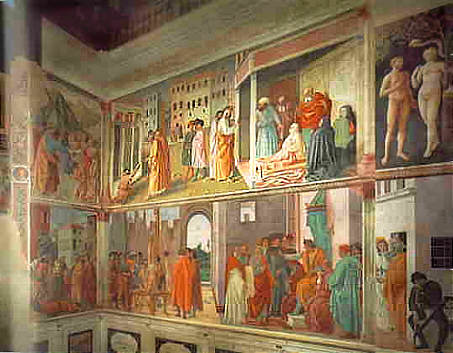
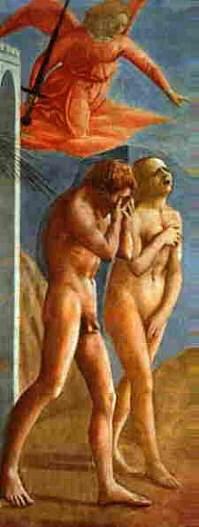 It is the narrative technique, the density and control of the
perspective depiction which makes Masaccio so unique. He never
was carried away by the fashion style of charming figures. His
faces are rough and powerful. Adam and Eve as opposed to Masolino
are an odd match. Masolino had never dared to paint such a very
expressive Eve.
It is the narrative technique, the density and control of the
perspective depiction which makes Masaccio so unique. He never
was carried away by the fashion style of charming figures. His
faces are rough and powerful. Adam and Eve as opposed to Masolino
are an odd match. Masolino had never dared to paint such a very
expressive Eve.
Well, there's so much to tell still. Perhaps about the tiny
church of SS. Apostoli (the oldest in town), which houses
flintstones of Jerusalem. It was a certain Pazzino de' Pazzi
(yes, one of THE Pazzi), who attented the first crusade in
1099 and climbed Jerusalem's walls as one of the first. From the grave of
Jesus
he brought back the stones who are still used on Easter-Sunday
when takes places the
Scoppio del Carro - the explosion of the cart.
Six white bulls carrying a guilt, decorated cart in front of the
cathedral. The priest in the duomo enlightens fire with the
flintstones and with this holy fire a papercard-dove will be lit,
whirrs through the duomo on a rope outside and hits the cart that
explodes. Or not. When the dove goes its way without problems its
a good sign for the coming year.
Or about the Via Tornabuoni whose pavements are the broadest
in the whole town, because here all the famous fashion designers
have their domicile. The expensive shops show noble modesty. No
acts, no flashing signs. You have to have a double look to
recognize Valentino, Saint Laurant, Versace and Gucci.
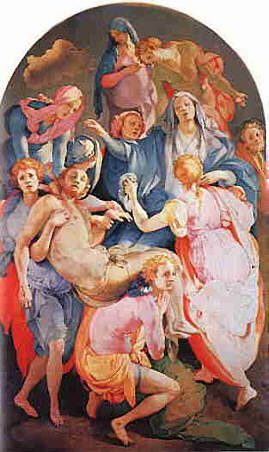
I could tell you about strange artists like Pontormo who was one of the
creator of the Florentine Manierism. You know, people with overlong
limbs and artificial posture. Vasari described it as "bella maniera",
thus the name. Pontormo used what I call 'Bonbon-colours',
but I do like it nonetheless. He lived alone in his house and pulled
up often the ladder leading to his attic, so it could happen that no
one of his friends knew if he was still alive or already dead. He
spent ten years of his life painting the freschi in the chancel of
San Lorenzo,
because he wanted to outdo Michelangelo. Tragically
they would all destroyed in the 18th century. Pontormo kept a
diary for the last three years of his life. He wrote there how
important he took his stomach, his kidneys and the other organs.
The author Bocchi reported, that Pontormo was "abnormally melancholic"
and "kept dead bodies in water bowls, to make them swell". He used
them for his studies for paintings and the stink poisoned the
whole surrounding. In the opposite to this Vasari tells that Pontormo
was terribly frightened of death. They never had to mention this
theme is his presence and the view of a funeral procession made him
sick. During a period of the plague he fled to the monks of the
monastery of Galluzo nearby the town.
Another candidate for mental disease was Il Rosso, called after
his fiery red facial colour. He liked to dig out corpses from the
cemetery of Arezzo, to study the influence of decay. He shared
his flat with a pavian whom he thought to serve him.
What about Andrea del Sarto, a fine painter, who was always
betrayed by his wife, but he was too dumb to see it. Or about
il Sodoma, the monks called Mataccio, the nut, because he painted
in a cloister naked whores trying to seduce monks. Shouldn't they
be lucky that he didn't paint naked boys seducing monks, for
Sodoma was proud of being gay?
Or that I had locked our whole money in the safe of our room
and only noticed it when we wanted to pay?
It's time to say good bye... A last time we stroll through
nighttime Florence. My eyes touching David as we enter the
yard of the Uffici. No look back, perhaps it doesn't hurt so
much then.
Arrivederci Firenze... and Benvenuto Pisa, our next station.
I'm sure nobody has seen the town per se, just the place of
miracles. I must confess I belong to them.
Pisa







 It is the narrative technique, the density and control of the
perspective depiction which makes Masaccio so unique. He never
was carried away by the fashion style of charming figures. His
faces are rough and powerful. Adam and Eve as opposed to Masolino
are an odd match. Masolino had never dared to paint such a very
expressive Eve.
It is the narrative technique, the density and control of the
perspective depiction which makes Masaccio so unique. He never
was carried away by the fashion style of charming figures. His
faces are rough and powerful. Adam and Eve as opposed to Masolino
are an odd match. Masolino had never dared to paint such a very
expressive Eve.

